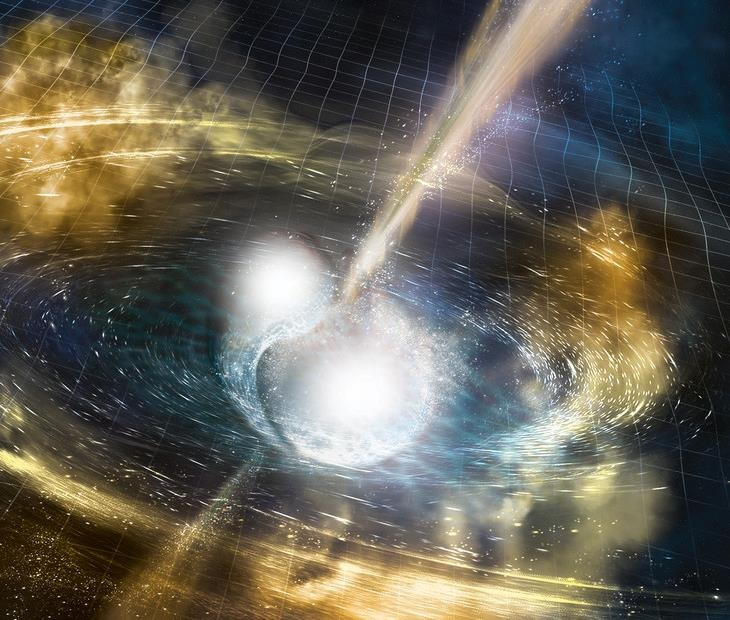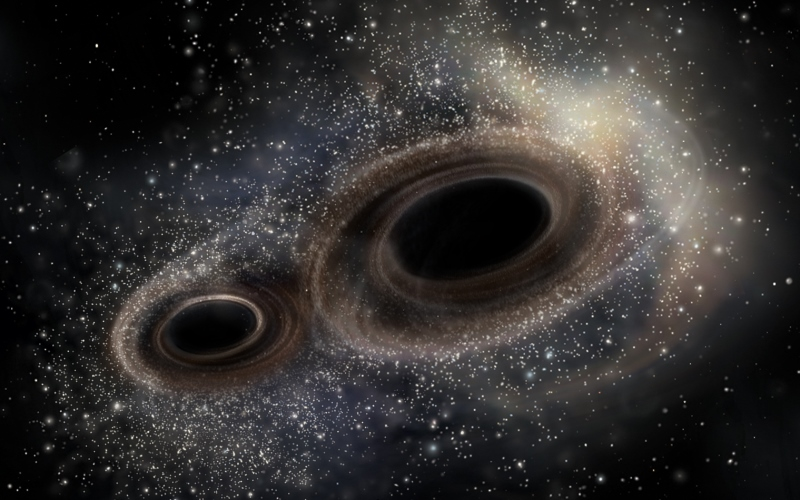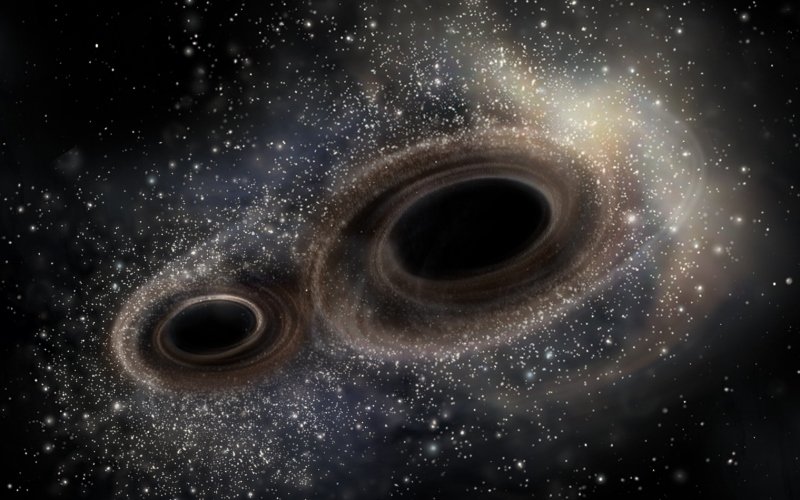Arts & Culture: Painting with Gravity’s Palette
Aurore Simonnet keeps an unassuming office: a cluttered shelf of books, an electric tea kettle, a cat calendar tacked to the desk. But the mundane environs belie the fantastical nature of her work. From a humble perch next to a copy machine, Simonnet imagines new answers to a century-old question: What does a gravitational wave look like?
A scientific illustrator at Sonoma State University in California, Simonnet collaborates with physicists at the Laser Interferometer Gravitational-Wave Observatory (LIGO) to create digital paintings of these ripples in spacetime and related astrophysical phenomena. She conjures up the scenes in outer space that produce gravitational waves: before, during, and after two black holes merge into one, as well as the collisions of orbiting neutron stars. “My job is to convey something that people don’t understand,” Simonnet says.
Simonnet’s involvement with LIGO began with the team’s first gravitational-wave detection, announced in 2016. Since then, her artwork has accompanied just about every big LIGO announcement—in press conferences, in popular videos on YouTube, and in The New York Times.
“Scientists will say 30 words or less to her, and she’ll go off and try to visualize it,” says physicist Lynn Cominsky, a member of the LIGO collaboration who works with Simonnet at Sonoma State. Using computer programs such as Adobe PhotoShop and Illustrator, Simonnet tries to visually replicate the scientists’ verbal descriptions and occasionally uses numerical simulations as a guide. Then she tweaks the digital paintings according to their feedback. “Usually within three iterations, she’s pretty much blown everybody away,” Cominsky says.
To imagine a scene in space, Simonnet considers the sources of light in the frame. “Space is dark unless you have a light source,” she says. “What you can see in space is light reflecting off whatever is happening around it. That’s what creates the shapes.” For inspiration, she studies images of light bending and reflecting in water and in other media.
Inevitably, Simonnet’s work blends fact with fiction. With no photos or human witnesses of these cosmic collisions to work from, she has to rely on her imagination. “There’s a lot of artistic license,” she says. The details of these astrophysical events are largely uncertain, and the art has to represent the scientists’ latest breakthrough, while glossing over their gaps in knowledge.
Simonnet’s favorite of her LIGO-commissioned pieces shows two black holes approaching each other on the inky backdrop of space (see top figure). Each black hole is surrounded by a whirlpool of light and a warped spacetime, which Simonnet represents with streaked curves that resemble long-exposure photographs of flowing water. The scene depicts the black hole merger that produced LIGO’s third detected gravitational wave.
Her responsibility, she says, is to make these faraway phenomena accessible to as many people as possible. To do this, she borrows familiar motifs from nature. “I use patterns that people are used to seeing on Earth, so they will be able to relate to an object in space better,” Simonnet says. In her painting of a neutron star merger, the stars resemble bright orbs submerged in water. They are superimposed on a web-like pattern of light inspired by octopus skin, Simonnet says.
Scientists and illustrators have long relied on similar creative processes to translate data “into something palatable,” says Geoff Belknap, a historian of visual culture based in the UK. To explain, Belknap cites The Pillars of Creation, the famous 1995 Hubble Space Telescope image of the Eagle Nebula. “If our eyes had the ability to look through a telescope and see that nebula, that’s not how it would look to us,” Belknap says. “It’s how a group of scientists and illustrators decided to interpret that data. There is no north, south, east, and west in the Universe. There is no up or down. But they put the data in a format that maps to our understanding of directions.”
The vivid detail of Simonnet’s paintings reflect how the science of gravitational waves has matured since Einstein’s original prediction. As physicist Daniel Kennefick of the University of Arkansas writes in his 2007 book, Traveling At The Speed of Thought, early descriptions of gravitational waves were dry and lifeless, referring to them abstractly as “rapidly variable fields,” for example. “One must suspect that this kind of phrasing is more intended to obscure what is not known than to describe what is known,” Kennefick says.
The language grew more colorful as researchers gained confidence in their knowledge of gravitational waves. Kennefick notes that around 1970, physicists began to compare gravitational waves with water, including the now-ubiquitous metaphor, “ripples in the curvature of spacetime,” and its variants. These descriptions roughly coincide with the building of the first prototype gravitational-wave detectors.
By 2016, when LIGO physicists reported the first gravitational-wave signal from merging black holes, they had more than just colorful descriptions. The announcement was accompanied by paintings and animations, including Simonnet’s. The researchers even composed a musical score of sorts, by converting the frequency of the detected gravitational ripple into an audible sound. The result was a bird-like “chirp” that signified the accelerated spiraling inwards of the two black holes.
Popular depictions of gravitational waves will continue to develop, as scientists better understand the phenomena. Recently, LIGO and its European counterpart, Virgo, have begun detecting gravitational waves routinely. The new signals hint at never-before-seen phenomena, like a neutron star being eaten by a black hole. To better imagine these exotic events, scientists may again call on the talents of artists like Simonnet.
–Sophia Chen
Sophia Chen is a freelance science writer in Tucson, Arizona.









